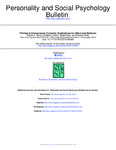Priming in interpersonal contexts: Implications for affect and behavior
| dc.contributor.author | Wyer, Natalie | |
| dc.contributor.author | Calvini, G | |
| dc.contributor.author | Nash, A | |
| dc.contributor.author | Miles, N | |
| dc.date.accessioned | 2014-04-03T11:54:45Z | |
| dc.date.accessioned | 2014-04-03T11:54:57Z | |
| dc.date.available | 2014-04-03T11:54:45Z | |
| dc.date.available | 2014-04-03T11:54:57Z | |
| dc.date.issued | 2010-12-01 | |
| dc.identifier.issn | 0146-1672 | |
| dc.identifier.issn | 1552-7433 | |
| dc.identifier.uri | http://hdl.handle.net/10026.1/2941 | |
| dc.description.abstract |
Priming stereotypes can lead to a variety of behavioral outcomes, including assimilation, contrast, and response behaviors. However, the conditions that give rise to each of these outcomes are unspecified. Furthermore, theoretical accounts posit that prime-to-behavior effects are either direct (i.e., unmediated) or mediated by cognitive processes, whereas the role of affective processes has been largely unexplored. The present research directly investigated both of these issues. Three experiments demonstrated that priming a threatening social group (“hoodies”) influences both affect and behavior in an interpersonal context. Hoodie priming produced both behavioral avoidance and several affective changes (including social apprehension, threat sensitivity, and self-reported anxiety and hostility). Importantly, avoidance following hoodie priming was mediated by anxiety and occurred only under conditions of other- (but not self-) focus. These results highlight multiple routes through which primes influence affect and behavior, and suggest that attention to self or others determine the nature of priming effects. | |
| dc.format.extent | 1693-1705 | |
| dc.language.iso | en | |
| dc.relation.replaces | http://hdl.handle.net/10026.1/2940 | |
| dc.relation.replaces | 10026.1/2940 | |
| dc.subject | Behavioral and Social Science | |
| dc.subject | Mental Health | |
| dc.subject | Mind and Body | |
| dc.subject | Basic Behavioral and Social Science | |
| dc.title | Priming in interpersonal contexts: Implications for affect and behavior | |
| dc.type | journal-article | |
| dc.type | Article | |
| plymouth.issue | 12 | |
| plymouth.volume | 36 | |
| plymouth.publication-status | Accepted | |
| plymouth.journal | Personality and Social Psychology Bulletin | |
| dc.identifier.doi | 10.1177/0146167210386968 | |
| plymouth.organisational-group | /Plymouth | |
| plymouth.organisational-group | /Plymouth/Research Groups | |
| plymouth.organisational-group | /Plymouth/Research Groups/Centre for Brain, Cognition and Behaviour (CBCB) | |
| plymouth.organisational-group | /Plymouth/Research Groups/Centre for Brain, Cognition and Behaviour (CBCB)/Cognition | |
| dcterms.dateAccepted | 2010-11-01 | |
| dc.identifier.eissn | 1552-7433 | |
| dc.rights.embargoperiod | Not known | |
| rioxxterms.versionofrecord | 10.1177/0146167210386968 | |
| rioxxterms.licenseref.uri | http://www.rioxx.net/licenses/all-rights-reserved | |
| rioxxterms.licenseref.startdate | 2010-12-01 | |
| rioxxterms.type | Journal Article/Review |


